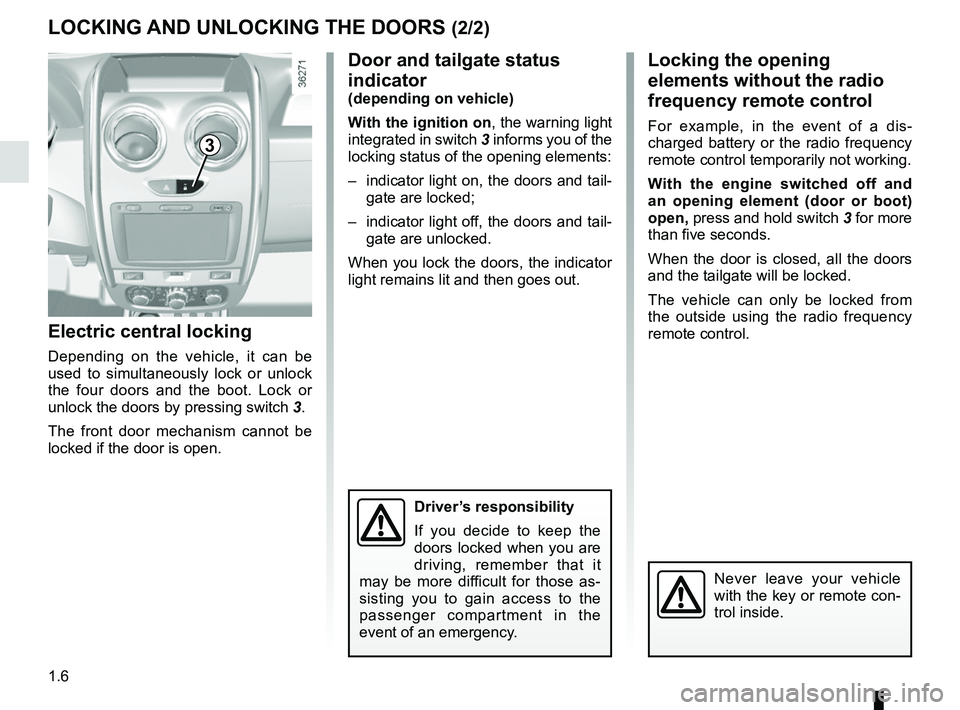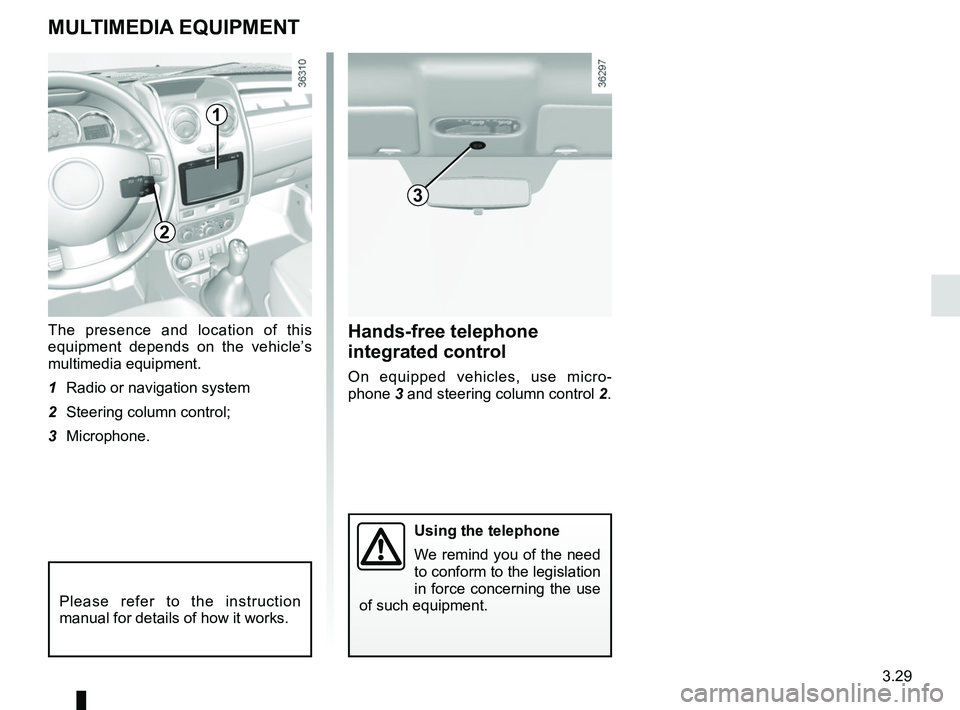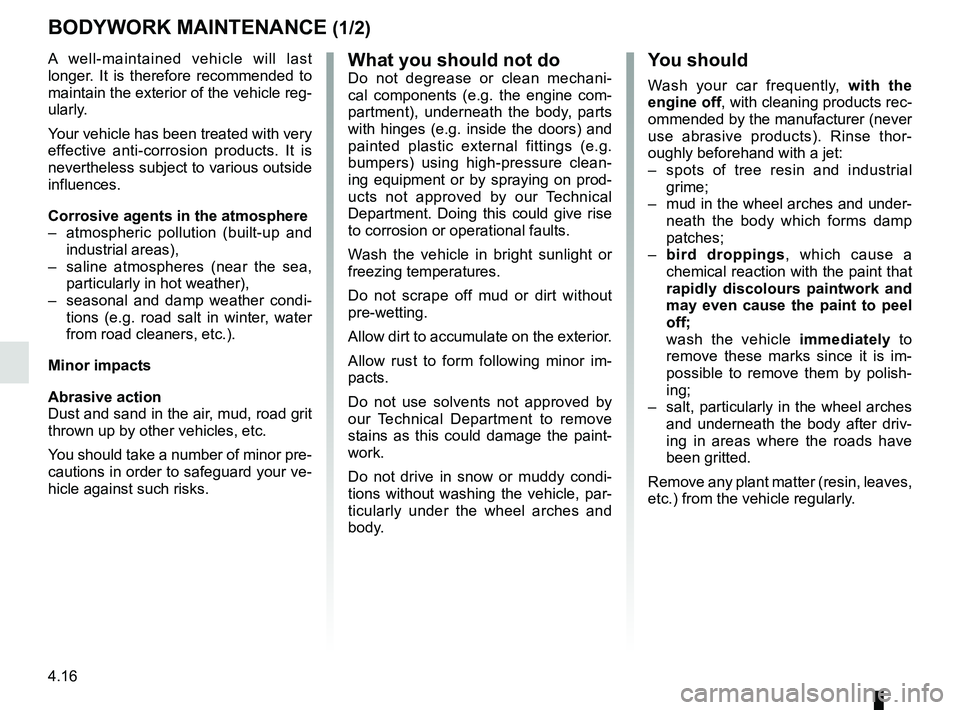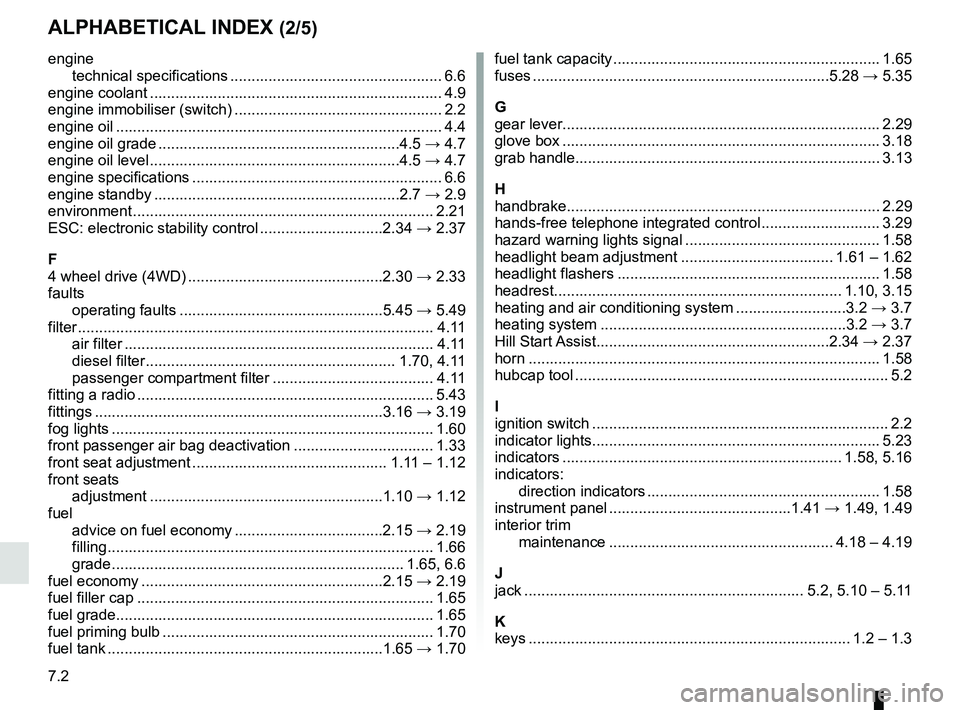EGR RENAULT DUSTER 2016 Owners Manual
[x] Cancel search | Manufacturer: RENAULT, Model Year: 2016, Model line: DUSTER, Model: RENAULT DUSTER 2016Pages: 256, PDF Size: 6.49 MB
Page 12 of 256

1.6
LOCKING AND UNLOCKING THE DOORS (2/2)
Electric central locking
Depending on the vehicle, it can be
used to simultaneously lock or unlock
the four doors and the boot. Lock or
unlock the doors by pressing switch 3.
The front door mechanism cannot be
locked if the door is open.
Driver’s responsibility
If you decide to keep the
doors locked when you are
driving, remember that it
may be more difficult for those as-
sisting you to gain access to the
passenger compartment in the
event of an emergency.
3
Never leave your vehicle
with the key or remote con-
trol inside.
Door and tailgate status
indicator
(depending on vehicle)
With the ignition on , the warning light
integrated in switch 3 informs you of the
locking status of the opening elements:
– indicator light on, the doors and tail- gate are locked;
– indicator light off, the doors and tail- gate are unlocked.
When you lock the doors, the indicator
light remains lit and then goes out.
Locking the opening
elements without the radio
frequency remote control
For example, in the event of a dis-
charged battery or the radio frequency
remote control temporarily not working.
With the engine switched off and
an opening element (door or boot)
open, press and hold switch 3 for more
than five seconds.
When the door is closed, all the doors
and the tailgate will be locked.
The vehicle can only be locked from
the outside using the radio frequency
remote control.
Page 27 of 256

1.21
The airbag is designed to complement the action of the seat belt. Both t\
he
airbags and seat belts are integral parts of the same protection system.\
It is therefore essential to wear the seat belt at all times. If seat be\
lts are
not worn, the occupants are exposed to the risk of serious injury in the\
event of an accident. It may also increase the risk of minor superficial\
injuries
occurring when the airbag is deployed, although such minor injuries are \
always
possible with airbags.
If the vehicle should overturn or suffer a rear impact, however severe, the pre-
tensioners and air bags are not always triggered. Impacts to the undersi\
de of the
vehicle, e.g. from pavements, potholes or stones, can all trigger these \
systems.
– No work or modification whatsoever may be carried out on any part of the
driver or passenger air bag system (air bag, electronic unit, wiring, e\
tc.), except
by qualified personnel from our Network.
– To ensure that the system is in good working order and to avoid accidenta\
l trig- gering of the system which could cause injury, only qualified personnel from
our Network may work on the air bag system.
– As a safety precaution, have the air bag system checked if your vehicle \
has been involved in an accident, or is stolen or broken into.
– When selling or lending the vehicle, inform the user of these points and\
hand over this driver’s handbook with the vehicle.
– When scrapping your vehicle, contact your approved Dealer for disposal o\
f the gas generator(s).
All of the warnings below are given so that the air bag is not obstructe\
d in any way when it is inflated and also to prevent
the risk of serious injuries caused by items which may be dislodged when\
the air bag inflates.
ADDITIONAL METHODS OF RESTRAINT
Operating faults
This warning light å will light up on
the instrument panel when the ignition
is switched on and then go out after a
few seconds.
If it does not light up when the ignition
is switched on, or if it lights up when the
engine is running, it indicates a fault in
the system. In this case, fitting a child
seat in the front passenger seat is
PROHIBITED.
Contact an approved dealer as soon
as possible. Your protection will be re-
duced until this fault is rectified.
Page 157 of 256

3.29
MULTIMEDIA EQUIPMENT
The presence and location of this
equipment depends on the vehicle’s
multimedia equipment.
1 Radio or navigation system
2 Steering column control;
3 Microphone.
Please refer to the instruction
manual for details of how it works.
Using the telephone
We remind you of the need
to conform to the legislation
in force concerning the use
of such equipment.
Hands-free telephone
integrated control
On equipped vehicles, use micro-
phone 3 and steering column control 2.
1
2
3
Page 174 of 256

4.16
BODYWORK MAINTENANCE (1/2)
You should
Wash your car frequently, with the
engine off, with cleaning products rec-
ommended by the manufacturer (never
use abrasive products). Rinse thor-
oughly beforehand with a jet:
– spots of tree resin and industrial
grime;
– mud in the wheel arches and under-
neath the body which forms damp
patches;
– bird droppings , which cause a
chemical reaction with the paint that
rapidly discolours paintwork and
may even cause the paint to peel
off;
wash the vehicle immediately to
remove these marks since it is im-
possible to remove them by polish-
ing;
– salt, particularly in the wheel arches
and underneath the body after driv-
ing in areas where the roads have
been gritted.
Remove any plant matter (resin, leaves,
etc.) from the vehicle regularly.
What you should not doDo not degrease or clean mechani-
cal components (e.g. the engine com-
partment), underneath the body, parts
with hinges (e.g. inside the doors) and
painted plastic external fittings (e.g.
bumpers) using high-pressure clean-
ing equipment or by spraying on prod-
ucts not approved by our Technical
Department. Doing this could give rise
to corrosion or operational faults.
Wash the vehicle in bright sunlight or
freezing temperatures.
Do not scrape off mud or dirt without
pre-wetting.
Allow dirt to accumulate on the exterior.
Allow rust to form following minor im-
pacts.
Do not use solvents not approved by
our Technical Department to remove
stains as this could damage the paint-
work.
Do not drive in snow or muddy condi-
tions without washing the vehicle, par-
ticularly under the wheel arches and
body.
A well-maintained vehicle will last
longer. It is therefore recommended to
maintain the exterior of the vehicle reg-
ularly.
Your vehicle has been treated with very
effective anti-corrosion products. It is
nevertheless subject to various outside
influences.
Corrosive agents in the atmosphere
–
atmospheric pollution (built-up and
industrial areas),
– saline atmospheres (near the sea,
particularly in hot weather),
– seasonal and damp weather condi-
tions (e.g. road salt in winter, water
from road cleaners, etc.).
Minor impacts
Abrasive action
Dust and sand in the air, mud, road grit
thrown up by other vehicles, etc.
You should take a number of minor pre-
cautions in order to safeguard your ve-
hicle against such risks.
Page 222 of 256

5.44
ACCESSORIES
Electrical and electronic accessories
Before installing this type of accessory (particularly for transmitters\
/receivers: frequency bandwidth, power level, po-
sition of the aerial, etc.), make sure it is compatible with your vehic\
le. You can get advice from an authorised dealer.
Connect accessories with a maximum power of 120 Watts only. Fire hazard. When several accessory sockets are
used at the same time, the total power of the connected accessories must\
not exceed 180 watts.
No work may be carried out on the vehicle’s electrical or radio circuits, except by authorised dealers: an incorre\
ctly connecte d
system may result in damage being caused to the electrical equipment and\
/or the components connected to it.
If the vehicle is fitted with any aftermarket electrical equipment, make\
sure that the installation is correctly protected by a fuse.
Establish the rating and position of this fuse.
Using the diagnostic socket
The use of electronic accessories on the diagnostic socket may cause ser\
ious disturbance to the vehicle’s electronic systems.
For your safety we recommend that you use only electronic accessories ap\
proved by the manufacturer, consult an Approved
Dealer. Serious accident risk.
Use of transmitting/receiving devices (telephones, CB equipment etc.).\
Telephones and CB equipment with integrated aerials may cause interferenc\
e to the electronic systems originally fitted to the
vehicle: it is advisable only to use equipment with an external aerial. \
Furthermore, we remind you of the need to conform
to the legislation in force concerning the use of such equipment.
Fitting aftermarket accessories
If you wish to install accessories on the vehicle: please contact an aut\
horised dealer. Also, to ensure the correct operation o f
your vehicle, and to avoid any risk to your safety, we recommend that you use only accessories specifically designed for y\
our
vehicle, which are the only accessories for which the manufacturer will \
provide a warranty.
If you are using an anti-theft device, only attach it to the brake pedal\
.
Obstructions to the driver
On the driver’s side, only use mats suitable for the vehicle, attached with the pre-fi\
tted components, and check the fitting re gu-
larly. Do not lay one mat on top of another. There is a risk of wedging the pedals.
Page 250 of 256

7.2
ALPHABETICAL INDEX (2/5)
enginetechnical specifications .................................................. 6.6
engine coolant ..................................................................... 4.9
engine immobiliser (switch) ................................................. 2.2
engine oil ........................................................................\
..... 4.4
engine oil grade .........................................................4.5 → 4.7
engine oil level ...........................................................4.5 → 4.7
engine specifications ........................................................... 6.6
engine standby ..........................................................2.7 → 2.9
environment ............................................................\
........... 2.21
ESC: electronic stability control .............................2.34 → 2.37
F
4 wheel drive (4WD) ..............................................2.30 → 2.33
faults operating faults ................................................5.45 → 5.49
filter .................................................................\
................... 4.11 air filter ........................................................................\
. 4.11
diesel filter ........................................................... 1.70, 4.11
passenger compartment filter ...................................... 4.11
fitting a radio ...................................................................... 5.43
fittings ...............................................................\
.....3.16 → 3.19
fog lights ........................................................................\
.... 1.60
front passenger air bag deactivation ................................. 1.33
front seat adjustment .............................................. 1.11 – 1.12
front seats adjustment .......................................................1.10 → 1.12
fuel advice on fuel economy ...................................2.15 → 2.19
filling ................................................................\
............. 1.66
grade ..................................................................\
... 1.65, 6.6
fuel economy .........................................................2.15 → 2.19
fuel filler cap ...................................................................... 1.65
fuel grade..............................................................\
............. 1.65
fuel priming bulb ................................................................ 1.70
fuel tank .................................................................1.65 → 1.70fuel tank capacity ............................................................... 1.65
fuses ..................................................................\
....5.28 → 5.35
G
gear lever..............................................................\
............. 2.29
glove box ........................................................................\
... 3.18
grab handle.............................................................\
........... 3.13
H
handbrake...............................................................\
........... 2.29
hands-free telephone integrated control ............................ 3.29
hazard warning lights signal .............................................. 1.58
headlight beam adjustment .................................... 1.61 – 1.62
headlight flashers .............................................................. 1.58
headrest................................................................\
.... 1.10, 3.15
heating and air conditioning system ..........................3.2 → 3.7
heating system ..........................................................3.2 → 3.7
Hill Start Assist.......................................................2.34 → 2.37
horn ...................................................................\
................ 1.58
hubcap tool ........................................................................\
.. 5.2
I
ignition switch ...................................................................... 2.2
indicator lights........................................................\
............ 5.23
indicators .............................................................\
..... 1.58, 5.16
indicators: direction indicators ....................................................... 1.58
instrument panel ...........................................1.41 → 1.49, 1.49
interior trim maintenance ..................................................... 4.18 – 4.19
J
jack .................................................................. 5.2, 5.10 – 5.11
K
keys ........................................................................\
.... 1.2 – 1.3